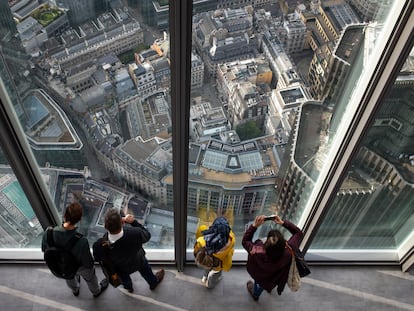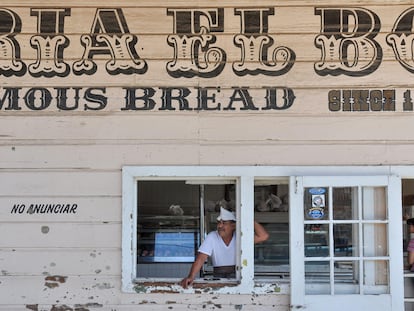Rotterdam, a cultural cradle for 2024
An impressive anthological exhibition dedicated to Ai Weiwei, the labyrinthine galleries of the Depot, a museum where gin has been distilled since 1700 and this year’s opening of new spaces for culture and leisure make the Dutch city a destination that must make your list
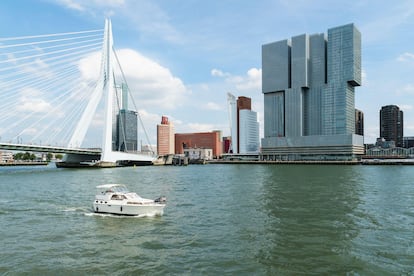
The city of Rotterdam is the engine of the Netherlands’ economic activity, mainly due to its port, which moves the most shipping containers in Europe and is one of the largest in the world. It features a spectacular skyline of avant-garde buildings, and every year, it vies for the top spot in the cultural sector with Amsterdam, forever its closest competitor. But it is the new exhibitions in Rotterdam’s museums and galleries that are the biggest attractions for potential visitors in 2024 — in addition to getting to know, or re-visiting, the city’s latest buildings, designed by top architects.
Perhaps the most relevant cultural landmark that awaits this winter in the port city is the vast anthological exhibition dedicated to Chinese artist and activist Ai Weiwei, now living in exile in London. The show includes installations, paintings, dioramas that illustrate his detention by Chinese authorities, and photographs in several galleries of the appealing Kunsthal art museum, ranging from early works to his latest creations.
In Search of Humanity, a concept that Ai seems to doubt he will ultimately find, brings together four decades of artistic expression, from his works related to his childhood in China, the repression suffered by his family in a labor camp during the Cultural Revolution, to the six-year imprisonment of his father. The exhibition will also include his reflections and denouncements captured on Ming vases, where images of African desert wanderers and shipwrecked boat people replace peasants and officials in the idyllic landscapes of ancient rural China. Above the heads of visitors to the exhibition zigzags a large snake made from a thousand students’ backpacks, rescued from underneath the rubble of schools that collapsed — and that would have stayed intact, had they been built according to safety regulations — during the 2008 earthquake in Sichuan, which caused some 90,000 deaths and missing persons in the region. In Search of Humanity will be on view at the Kunsthal through March 4, and is a must-see on any visit to Rotterdam during the next few months.
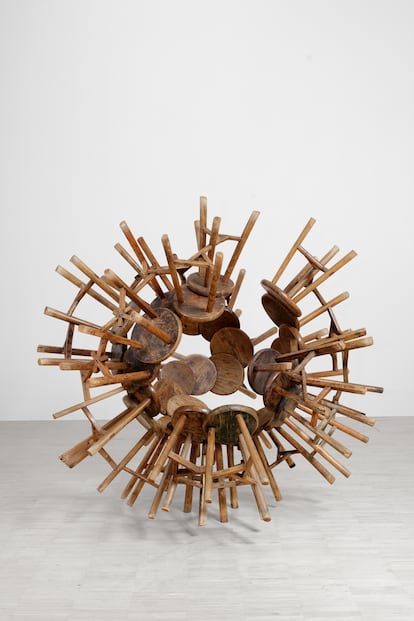
Another gem can be found at the Stedelijk Museum in Schiedam, a municipality located alongside the westernmost neighborhoods of Rotterdam, just a few minutes away from downtown by public transportation. On display until February 25 is the Yayoi Kusama exhibition Dutch Years (1966-1970), a period in which the Japanese artist, born in in 1929, served as a reference for the countercultural Provo movement. Kusama recognizes three principal obsessions as motivations for her work, all of them the subjects of repellant hallucinations she experienced in childhood: sex, flowers and … macaroni. The trio materializes in installations and collages throughout several of the museum’s galleries: dresses with fragments of Italian pasta attached, sculptures formed by piles of penises and the proliferation of another one of the fixations of Kusama — who has been voluntarily committed to a Japanese mental health facility since the 1970s, from which she leaves for hours-long periods to work. Here too are her colored polka dots on fashion designs, mannequins, or even painted live on the naked bodies of other artists, as shown in the photos of 1960s happenings that took place in galleries in Amsterdam and other Netherlands cities, which scandalized many, even in a society as liberal as that of the Dutch.
After visiting the Stedelijk, a beautiful building that once housed a hospital in the late 18th century and is located in the town’s historic center, savvy travelers will stroll along the tree-lined docks of the nearby Lange Haven canal. Docked in its waters are houseboats that make for delightful scenery. Coupled with the 18th-century buildings that flank the canal, they form a classic panorama typical of several cities in the Netherlands. Not to be missed on this street is the fascinating National Museum of Jenever, dedicated to the Dutch gin. Visitors will learn how the beverage has been distilled in this very building since 1700, and about how much of its production is exported to other parts of the world. In addition, the museum will be hosting an exhibition on the industry’s use of precious Delft blue pottery, through February 25.
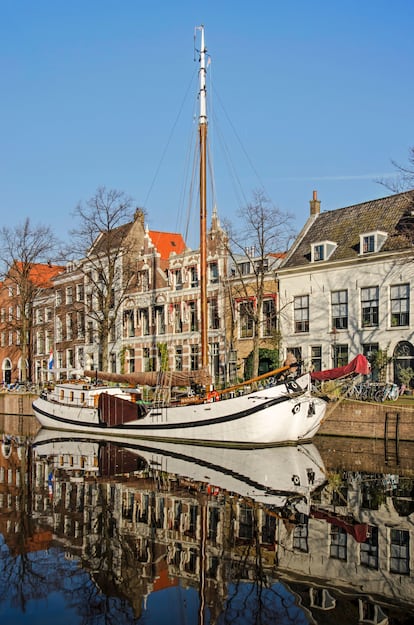
Back in the city center, Boijmans van Beuningen, Rotterdam’s primary art museum, will be closed for renovation until at least 2028, but you can see some of its works in the Depot, an impressive building that opened in 2021 in the Museumpark, next to the former Boijmans. Only a slim percentage of the 150,000 canvases, sculptures and design objects were transferred from the lavish museum to be displayed in their temporary home, but the highlights of the collection are not to be missed. Through March 24, there are 14 works by Bosch, Titian, Kandinsky, Monet, Mondrian and Basquiat, and after that date, visitors will find up to 70 masterpieces being shown on the building’s fifth floor. It’s also quite interesting to take a look at the large spaces in which works are stored and restored. Of course, what will likely surprise travelers most on this visit will be the building itself. A cup-shaped structure standing at over 131 feet tall, the Depot features over 161,000 square feet of space used to store artistic treasures, hidden behind a façade of reflective glass.
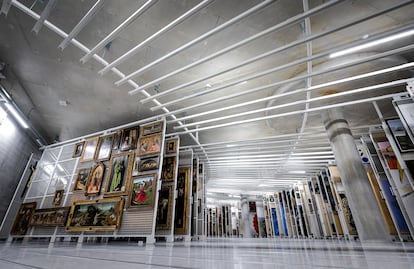
Another stand-out showing at the Depot will be on display through January 14, tucked away in a room on the top floor accessed by glass elevators or stairs rising up between large showcases. There you will find design objects hailing from ancient cultures like Chinese porcelain and Mesopotamian vessels, late-20th century furniture, or even a medieval canvas positioned in front of the work of a Surrealist painter. It also hosts the exhibition Art Among the Ruins, which illustrates how Rotterdam artists survived (and sometimes collaborated) in the years following the bombing that destroyed the city in 1940, during the Nazi occupation. Some created oil paintings with neutral themes so as not to offend the occupying forces, of which the most common subject was landscapes (“a theme that never bothered the Nazis,” according to a museum guide), and others went so far as to insert a tiny, almost-imperceptible swastika in the middle of a painting of desolation, as a nearly invisible denunciation of censorship.
In a city that had to rise from the ashes at the end of World War II, and that grew rich over the following years thanks in large part to the activity of its Europoort, whose commercial volume was only surpassed in 2004 by the Shanghai and Singapore ports, it’s highly recommended to visit Europe’s largest maritime entry and exit point, which stretches 26 miles long and has a total area of 41 square miles. The company Spido offers various daily hour-and-a-half-long cruises that travel through the port, via the mouths of the Rhine and Meuse rivers, that depart from next to the Erasmus Bridge. Later this year, the new Portlantis visitor center is scheduled to open at Maasvlakte 2, a site that was reclaimed from the North Sea at the westernmost end of the superport, a state-of-the-art project, “a machine to reveal the incredible world of the port,” according to Winy Maas, founding partner of MVRVD, the architectural firm that won the competition to design the project.
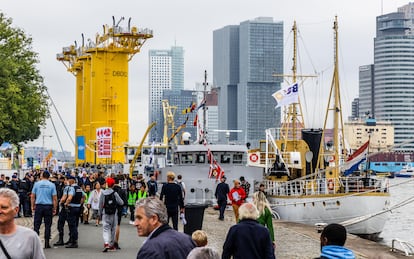
Those interested in avant-garde architecture will find in Rotterdam a series of lavish buildings and skyscrapers on a walk through downtown and its other neighborhoods: the aforementioned Depot, Central Station, the iconic Cube Houses … There’s also the Markthal, located in front of the houses, a striking arch that contains 200 apartments and whose interior dome features beautiful murals of flowers and fruits, sheltering a charming food market. There, one is drawn to stalls of traditional and local products: cheeses, jenever, chocolates … food whose quality practically calls out to passers-by. Other architectural options are found in the impressive McDonald’s pavilion in Coolsingel, designed by Robert Winkel; the Stock Exchange and the World Trade Center, the imposing Willemswerf, headquarters of the Maersk shipping company. You might also take a look at the progress of the futuristic building that will house the FENIX Museum of Immigration, slated to open in 2025, a mind-blowing metal spiral inserted into a 1920s Holland America Line maritime warehouse on the lower bank of the Meuse.
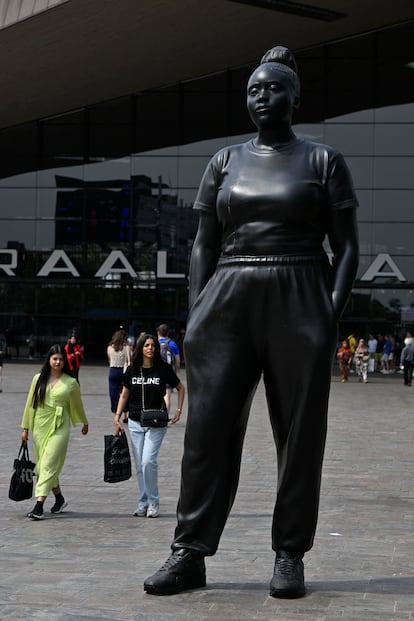
And soon, there will even be a stand-out option for Rotterdam visitors looking to unwind after experiencing the city’s dazzling array of cultural offerings. Next summer will see the opening of RiF010 Urban Surfing, a site in the central Steigersgracht area, located on another one of the country’s ubiquitous canals, where you will be able to ride the waves in kayaks, bareback or even have a good time on a rafting circuit.
Sign up for our weekly newsletter to get more English-language news coverage from EL PAÍS USA Edition
Tu suscripción se está usando en otro dispositivo
¿Quieres añadir otro usuario a tu suscripción?
Si continúas leyendo en este dispositivo, no se podrá leer en el otro.
FlechaTu suscripción se está usando en otro dispositivo y solo puedes acceder a EL PAÍS desde un dispositivo a la vez.
Si quieres compartir tu cuenta, cambia tu suscripción a la modalidad Premium, así podrás añadir otro usuario. Cada uno accederá con su propia cuenta de email, lo que os permitirá personalizar vuestra experiencia en EL PAÍS.
¿Tienes una suscripción de empresa? Accede aquí para contratar más cuentas.
En el caso de no saber quién está usando tu cuenta, te recomendamos cambiar tu contraseña aquí.
Si decides continuar compartiendo tu cuenta, este mensaje se mostrará en tu dispositivo y en el de la otra persona que está usando tu cuenta de forma indefinida, afectando a tu experiencia de lectura. Puedes consultar aquí los términos y condiciones de la suscripción digital.
More information
Archived In
Últimas noticias
The complicated life of Francesca Albanese: A rising figure in Italy but barred from every bank by Trump’s sanctions
From digital curfews to blocking apps: How technology experts protect their children online
Why the price of coffee has skyrocketed: from Brazilian plantations to specialty coffee houses
Confined to a Cuban hospital: When electricity is a matter of life or death
Most viewed
- Pablo Escobar’s hippos: A serious environmental problem, 40 years on
- Why we lost the habit of sleeping in two segments and how that changed our sense of time
- Trump’s obsession with putting his name on everything is unprecedented in the United States
- The Florida Keys tourist paradise is besieged by immigration agents: ‘We’ve never seen anything like this’
- Charles Dubouloz, mountaineering star, retires at 36 with a farewell tour inspired by Walter Bonatti
